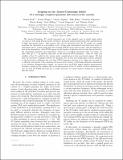Files in this item
Four-wave mixing dynamics of a strongly coupled quantum-dot–microcavity system driven by up to 20 photons
Item metadata
| dc.contributor.author | Groll, Daniel | |
| dc.contributor.author | Wigger, Daniel | |
| dc.contributor.author | Jürgens, Kevin | |
| dc.contributor.author | Hahn, Thilo | |
| dc.contributor.author | Schneider, Christian | |
| dc.contributor.author | Kamp, Martin | |
| dc.contributor.author | Höfling, Sven | |
| dc.contributor.author | Kasprzak, Jacek | |
| dc.contributor.author | Kuhn, Tilmann | |
| dc.date.accessioned | 2020-07-02T12:30:02Z | |
| dc.date.available | 2020-07-02T12:30:02Z | |
| dc.date.issued | 2020-06-04 | |
| dc.identifier | 268137499 | |
| dc.identifier | ada11d0b-9edd-47bb-ba5f-5f19e85af0e8 | |
| dc.identifier | 000537619300005 | |
| dc.identifier | 85086997755 | |
| dc.identifier.citation | Groll , D , Wigger , D , Jürgens , K , Hahn , T , Schneider , C , Kamp , M , Höfling , S , Kasprzak , J & Kuhn , T 2020 , ' Four-wave mixing dynamics of a strongly coupled quantum-dot–microcavity system driven by up to 20 photons ' , Physical Review B - Condensed Matter and Materials Physics , vol. 101 , no. 24 , 245301 . https://doi.org/10.1103/PhysRevB.101.245301 | en |
| dc.identifier.issn | 1098-0121 | |
| dc.identifier.uri | https://hdl.handle.net/10023/20194 | |
| dc.description | D.W. acknowledges financial support by the Polish National Agency for Academic Exchange (NAWA) within the ULAM program (No. PPN/ULM/2019/1/00064). The Würzburg team acknowledges the support by the State of Bavaria and the Deutsche Forschungsgemeinschaft (DFG) within Project No. SCHN1376 5.1 / PR1749 1.1. | en |
| dc.description.abstract | The Jaynes-Cummings (JC) model represents one of the simplest ways in which single qubits can interact with single photon modes, leading to profound quantum phenomena like superpositions of light and matter states. One system, that can be described with the JC model, is a single quantum dot embedded in a micropillar cavity. In this joint experimental and theoretical study we investigate such a system using four-wave mixing (FWM) micro-spectroscopy. Special emphasis is laid on the dependence of the FWM signals on the number of photons injected into the microcavity. By comparing simulation and experiment, which are in excellent agreement with each other, we infer that up to ∼20 photons take part in the observed FWM dynamics. Thus we verify the validity of the JC model for the system under consideration in this non-trivial regime. We find that the inevitable coupling between the quantum dot exciton and longitudinal acoustic phonons of the host lattice influences the real time FWM dynamics and has to be taken into account for a sufficient description of the quantum dot-microcavity system. Performing additional simulations in an idealized dissipation-less regime, we observe that the FWM signal exhibits quasi-periodic dynamics, analog to the collapse and revival phenomenon of the JC model. In these simulations we also see that the FWM spectrum has a triplet structure, if a large number of photons is injected into the cavity. | |
| dc.format.extent | 6786393 | |
| dc.language.iso | eng | |
| dc.relation.ispartof | Physical Review B - Condensed Matter and Materials Physics | en |
| dc.subject | QC Physics | en |
| dc.subject | T-NDAS | en |
| dc.subject.lcc | QC | en |
| dc.title | Four-wave mixing dynamics of a strongly coupled quantum-dot–microcavity system driven by up to 20 photons | en |
| dc.type | Journal article | en |
| dc.contributor.institution | University of St Andrews. Condensed Matter Physics | en |
| dc.contributor.institution | University of St Andrews. School of Physics and Astronomy | en |
| dc.identifier.doi | 10.1103/PhysRevB.101.245301 | |
| dc.description.status | Peer reviewed | en |
| dc.date.embargoedUntil | 2020-06-04 |
This item appears in the following Collection(s)
Items in the St Andrews Research Repository are protected by copyright, with all rights reserved, unless otherwise indicated.

